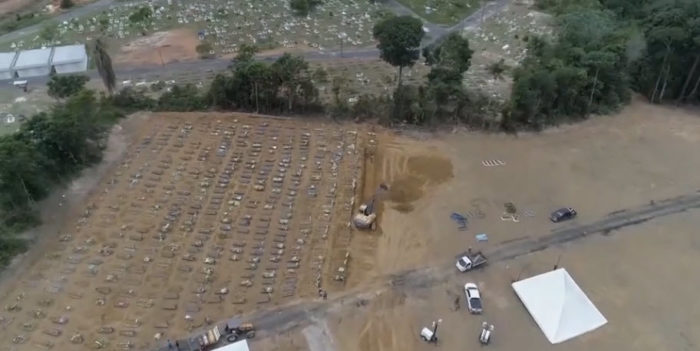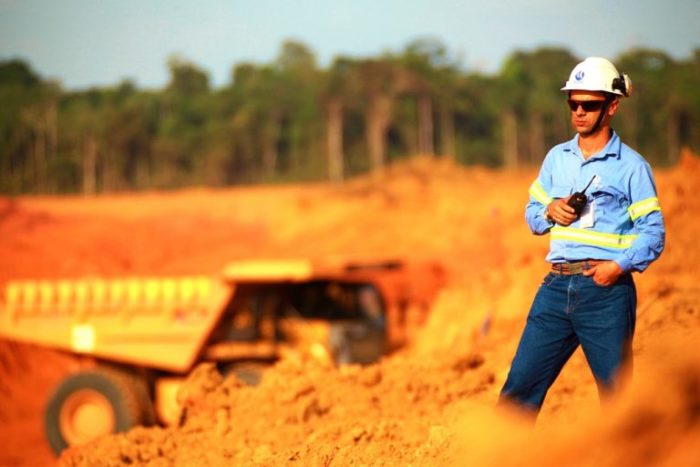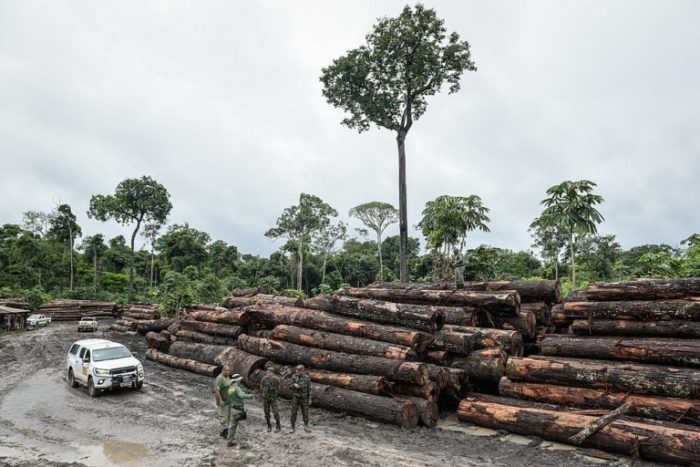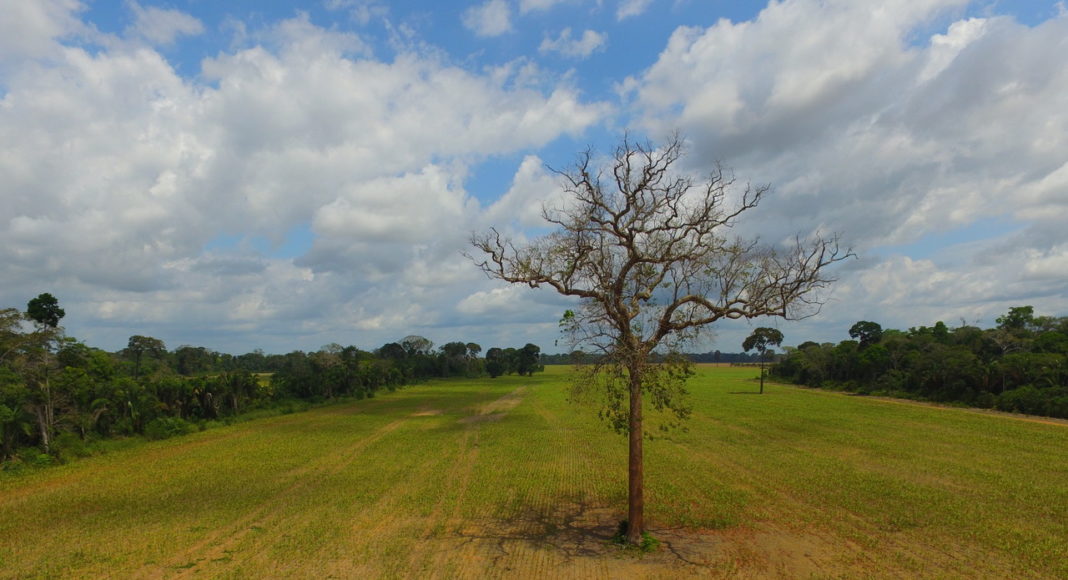This article was edited by LAB. The authors’ original text (in Portuguese) can be found here.
The authors argue that the acceleration of Amazonian deforestation and environmental degradation —powered by successive blows from Bolsonaro’s government to neuter environmental protection policies — in a region where public healthcare is at best precarious, has amplified the lethality of diseases, especially Covid-19.
Removing protection from indigenous lands
In less than a month, the world has watched with bated breath as Brazil has seen a five-fold increase in the number of deaths from Covid-19. In the same period, the country’s environmental protection policy has suffered at least five lethal blows.

On April 22, exactly 520 years after the outbreak of the largest genocide in the history of Brazil, the so-called ‘Discovery’, FUNAI (National Foundation for Indians), the body charged with promoting the defense of native people’s rights and guaranteeing the health and hygiene of the territories occupied by these groups, published Normative Instruction No. 09. This determines that all indigenous lands that are not in the final stage of state recognition shall be excluded from the database of the National Land Management System (SIGEF). In practice, this NI removes protection from the vast majority of indigenous territories, including many that have spent long years in claims procedures and those occupied by groups who are in voluntary isolation. In practice, this NI validates private property holdings and title deeds previously annulled by Article 231 of the 1988 Constitution, as well as encouraging non-indigenous occupation of these lands. It is crucial to remember that indigenous lands are the areas with the lowest rates of environmental degradation in the country.
Soon after, on 30 April, two of the main environmental surveillance coordinators of IBAMA (Brazilian Institute of the Environment and Renewable Natural Resources) were summarily removed from office. Everything indicates that these sackings were in retaliation for their work to investigate and combat grandiose, complex projects which pillage natural resources.

The dismissals occurred soon after a large-scale operation to combat illegal mining in the Amazon and after the team, coordinated by the two civil servants, had managed to reduce deforestation in 2020 to zero in in the Ituna-Itatá indigenous territory, until then the worst affected area. This was the more remarkable given the severe constraints already limiting IBAMA’s operations.
Less than a week later, the Presidency of the Republic published decree no. 10,344, placing all federal environmental protection agencies and organisations under the command of the Armed Forces. IBAMA, ICMBio, the Federal Police, and FUNAI have all lost their operational independence and become subordinate to the military, who now have the power to define the places to be inspected and the procedures to be adopted.
The same act authorized the GLO (Guarantee of Law and Order) in the Legal Amazon area between 11 May and 10 June, 2020. This GLO should cost around R$60 million. IBAMA’s environmental surveillance budget for the entire year is R$74 million; in other words, more than 80 per cent of the year’s available resources will be used on this alone.
Up to now, there has been no report of the confiscation and destruction of a single machine used in illicit activities. It is important to remember that the destruction of backhoe excavators, crawler tractors, and other machines, which each cost R$500,000, on average, is an indispensable legal mechanism to give teeth to surveillance operations. These operations were carried out mainly by IBAMA, and caused significant pain to its opponents, many of whom occupy important positions in the legislatures.

On 12 May, the precarious state of the already debilitated ICMBio (Chico Mendes Institute for the Conservation of Biodiversity) worsened further. The agency is responsible for the management and surveillance of federal conservation units, which are areas of great environmental importance. The decree abolished 11 regional coordination centres, replacing them with five regional administrations for the entire country, four of which are situated in cities far from the places which they are supposed to protect.
Until now there were five regional coordination centers in the Amazon. Now, there is one regional administration for the entire biome, which contains around 130 conservation units. Most of those appointed to the new administrations are retired military, with no previous experience in environmental management. These appointments further swell the military ranks of the agency, whose presidency and four general-director posts are occupied by military policemen from São Paulo. It is no coincidence that the position of surveillance coordinator remains vacant.
This aberration is typical of the ‘necropolitics’ now prevailing in Brazil. It constitutes a clear attempt to subordinate all public agencies and institutions to the whim of the Executive, in a direct challenge to constitutional power and authority. This is one of the reasons that led the V-Dem Institute of Gothenburg University to demote Brazil drastically in its ranking of states on the democracy – authoritarian scale.
A bonfire of forest regulations
The anger of the present government and its supporters, however, is not satisfied by their attacks on agency surveillance and regulation of illegal activity in respect to land holding. Now they have turned their attention to redefining which kinds of deforestation can be authorized. The measure they have used is Decree 10,347, published on 14 May which, in direct contradiction to a provision of the law that regulates the administration of public forests, excludes the technical division of the Ministry for the Environment from the process of determining in which areas forest products can be exploited. The legality of this decree is being challenged in court, through an actio popularis in Belém.
Under this new decree, the drawing up and approval of the Annual Forestry Grant Plan (PAOF) becomes exclusively the job of the Ministry for Agriculture, Livestock, and Supply (Mapa), whose overriding function is the expansion of the agricultural frontier. To get an idea of how catastrophic this measure may prove, the PAOF plan for 2020 envisages making 7,750 million hectares of federal public forest subject to concession. This represents an area 50 times the size of the city of São Paulo, and eight times larger than the total amount of clear-cut deforestation detected by satellite between August 2018 and July 2019, which in turn was the highest level in a decade.

Strictly speaking, the forestry concessions authorize selective felling of trees for timber, which should in theory reduce the scale of forest loss. However, the reality is more worrying. Almost always, timber extraction culls all forestry species that have any market value and ignores the cutting cycles of proper forest management. The plans filed are almost always fictitious, serving to cover the looting of wood from indigenous lands and areas of special protection.
With this in mind it is reasonable to ask why a ministry tasked with promoting rural activities that usually demand extensive areas of open ground, such as agriculture and livestock, should wish to have exclusive control of the future of public forests, which are supposed to be exploited through selective felling, not by clearance. In 2020 almost 8 million hectares of forest disappeared. From 2021 onwards it seems highly probable that this number will rise significantly.
The scenario is frightening: uncontrolled illegal deforestation breaking new records each year, and deforestation authorized by those whose job is to open up new areas for agriculture. This is a recipe for disaster.
Clearing the ground for pandemics
According to the WHO (World Health Organization), pandemic is the expression used to describe a pathology that quickly spreads to various parts of the planet simultaneously. The same term might be used to define the virulent fury that large scale agribusiness directs towards the various biomes of the world.
It is crucial to recall that destruction of the forests is directly linked to the appearance and escalation of pathologies. As Carlos Nobre emphasizes: ‘The Amazon has the highest quantity of microorganisms in the world. And, we are disturbing the system all the time, with urban populations getting closer, deforestation, and the trade in wild animals’. In this dystopian scenario, Amazonian peoples are today in greater danger than the forest itself, given their multiple vulnerabilities, the losses they suffer and the biological disorder which threatens them.
If the forest is cleared, a valuable system protecting human health will also be lost, not only for those that live close to the forest, but for the entire nation. The forest provides a health service of inestimable value when it is the source of quality water, food safety, and climate equilibrium. Deforestation and other forms of environmental degradation are a direct cause of the appearance of various diseases of large-scale social impact, both locally and globally.
The reduction in Amazon forest cover transforms the naturally acid pH of the forest into a pH close to neutral, creating favorable conditions for the proliferation of the Anopheles mosquito, a vector of malaria. The accelerated deforestation that began in the Amazon at the end of the 1970s brought with it a proportional increase in cases of malaria, reaching a peak in 1999, when 632,000 cases of the disease were recorded.
After 2005, malaria cases were reduced by almost 80 per cent through a series of diagnosis and treatment measures, declining to 130,000 cases in 2016. Sadly, but predictably, as deforestation in the last two years intensified, the number of malaria cases has once more increased by more than 50 per cent.
In 2016, Amazonas was the state with the highest incidence of tuberculosis in the country, recording 67.2 cases per 100,000 thousand inhabitants, over double the national average.
The poverty, inequality, and precarious sanitation prevalent in most Amazonian cities, resulting from decades of predatory development, provide excellent conditions for the proliferation of diseases such as dengue, chikungunya, and zika, which were previously more common in other regions of Brazil. Currently, the Amazon is responsible for 95% of the cases of Chagas disease in Brazil.
Shattering the equilibrium between society and environment
When this fragile equilibrium between the environment and society is broken, it leads to the appearance of new diseases and the reappearance of forgotten evils. It is no accident that the five cities with the highest rates of lethality from Covid-19 are located in the Amazon region (Tabatinga, Manacapuru, Autazes, Coari, and Iranduba) – and they are precisely those where inequality and the imbalance between humans and the environment is most acute. What we are stating here is not a relationship of cause and effect, but the finding that the socioeconomic and structural fragility of healthcare services is found alongside high lethality in these communities.
The galloping increase in cases of tuberculosis and Covid-19 infection is registered just where the backhoes of the illegal miners contribute to the mercury poisoning of thousands of people in the Amazon. In a savage irony, these same machines today are excavating shallow communal graves for the victims of Covid-19 in Manaus.
There was no quarantine declared for illegal deforestation and mining. They obeyed no order to take time off work. Contrary to all environmental prescriptions, this destructive pathology has intensified at a time when indigenous communities are becoming ill and locking themselves down inside their territories, afraid and with no way of resisting the invaders.
Around and even within indigenous areas, illegal mining proliferates, driven by the virulence and brute strength of men who risk their lives for dreams of wealth. They are not deterred by any virus. The lowly miners (men who are themselves victims of the absence of public policy for land use and employment) are also a fragile link in the parasitic chain that exposes them to death, even as it feeds the wealth accumulation of their masters.
Despite Covid-19 reaching people of all races and social classes without distinction, not all are equally harmed. We are living, according to Achille Mbembe, in times characterized by an ‘unequal redistribution of vulnerability’. Indigenous people present greater vulnerability to the disease for both biological and sociocultural reasons.
God is great, but the forest is bigger — Amazon proverb
Juxtaposed with this is the precarious situation of the healthcare system. The worst ratios of ICU beds and doctors to inhabitants are in the states of the Amazon, where the people and the forest are being stripped away. For example, medicines and other medical equipment take an average of 15 days to be delivered to a city in the interior of the Amazon… if it is actually delivered at all. The Amazon has become the end of the world in providing healthcare to its inhabitants, but the beginning of the world in providing a cornucopia of forest riches and easy profits.
Covid-19 has further exposed the raw and bleeding wounds of certain Amazonian populations and of an exhausted forest. Now they are the targets for hard and possibly fatal blows in the form of normative instructions, decrees, plans, and a GLO. The legacy of these measures remains unknown. What can be stated is that this succession of events triggers a chain reaction –environmental devastation leads to the appearance of diseases and large reductions in population, while the environment itself becomes susceptible to an incurable pandemic of destruction.
There is an old Amazonian proverb which says, ‘God is great, but the forest is bigger’ – it just remains to be seen if anything will be left of it. Covid-19 seems to have found in Brazil the most favorable comorbidity for its lethal fury – the Brazilian State.
Main image: Land cleared for soya on the Jerusalém plantation at Belterra, near Santarém, Pará. Unusually the owner, Celso Pezzini Rech, was convicted in 2018 for illegally clearing 124 hectares of forest in Amazônia Legal, after being denounced by IBAMA. Under Bolsonaro’s new measures such a prosecution would be impossible. Photo: Marcos Colón/Fordlandia
Marcos Colón received his PhD in Cultural Studies from the Wisconsin-Madison University, and is professor in the Department of Modern Languages and Linguistics at Florida State University. He is the director of the documentary “Beyond Fordlândia”.
Luís de Camões Lima Boaventura is prosecutor for the Republic and studying for a Master’s in Law at the University of Brasília.
Erik Jennings is the coordinator of the medical residency in neurology at the Lower Amazonas Regional Hospital (Hospital Regional de Baixo Amazonas) (State University of Pará), in Santarém, a doctor for Sesai (Special Secretary for Indigenous Health) and the author of “Paradô: Histórias de um Neurocirurgião do Interior da Amazônia” (Paradô: Histories of a Neurosurgeon in the Amazonian Interior) and “Olhando o Rio” (Looking at the River).

